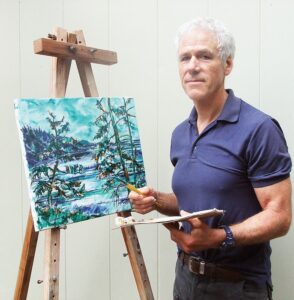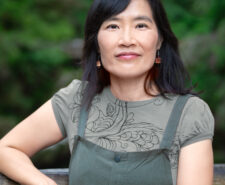The art of the walking guide
July 23rd, 2025

Retired educator, artist and lifelong adventurer, Theo Dombrowski (at right) has built a life around exploration—both in the wild and in written form. As co-author of popular guidebooks like Family Walks and Hikes of Vancouver Island (Rocky Mountain Books), he has shown readers how to discover the rugged beauty of the outdoors. In conversation with BC BookLook, he shares moments from childhood hikes, close-up wildlife encounters and how retirement has reshaped his relationship with nature—and with himself.
BCBookLook: Do you remember your very first hike as a kid, where was it and what stuck with you most from that day?
Theo Dombrowski: Mount Arrowsmith for any child growing up in Port Alberni is iconic—and fascinating. How exciting, therefore, to be taken by my parents to the creek crossing just off the highway between Cathedral Grove and the bottom of “The Hump” and begin winding up the mountain through giant Douglas Firs and Hemlocks. How far my family got up the mountain I don’t remember, but the thrill of being on the mountain remains. The trail, however, does not remain. MacMillan and Blooded clearcut the entire mountainside shortly after.
BCBL: Writing guidebooks is part adventure, part logistics. What’s the weirdest or most unexpected thing that’s ever happened while researching a hike?
TD: Feeling in need of a wee rest, I left the trail down King’s Peak to go a short distance away through a cleared area under power lines to a comfortable spot. Feeling better, I returned to the trail to discover that, once in the forest, the trail curved to run parallel to the cleared area and immediately behind the spot in which I had been resting. There, in full 3D reality, was a cougar facing the spot which I had just left, giving a very convincing impression of a large cat about to pounce. The next step: the cougar got up (grudgingly it seemed to me) and disappeared into the trees.
BCBL: When you’re not hiking or writing about hiking, what are you doing and how do those activities connect with your time on the trail?
TD: The glory of being retired from regular work means that there is a great opportunity to do so many other things, long postponed. I’m outdoors every day, riding a mountain bike, building mountain biking trails, sea kayaking and, in season, skiing or snowboarding. Indoors, I’ve found a lot of satisfaction volunteering English tutoring immigrants, writing book reviews for the British Columbia Review, playing the piano, coaxing reluctant vegetables to grow and adding new paintings to my website (where all profits go to charity). As all retired folk say, the days are too short!
BCBL: How do you decide which trails to include in your books?
TD: I love to include the whole range of trails from the thoroughly established and iconic to the little-known and out-of-the-way. Always, though, perhaps the two key issues for me are beauty—rarely in short supply—and accessibility. After all, too many wonderful trails on Vancouver Island are behind locked logging road gates or along eroded and now impassable logging roads.
BCBL: Which trail feels most like “home”? Why?
TD: One soggy spring day, my intrepid Boy Scout leaders headed up Sproat Lake in boats to the heavily snow clad and cloud covered Mt. Kiltsa, in those days, was accessible only by boat. Though the conditions were wretched and the steep snow slopes a little scary, the excitement was huge. Since then I have been back many, many times and always feel both the novelty of seeing new details and a familiarity that feels like home.
BCBL: If your books could leave readers with one lasting feeling or realization about the natural world, what would you hope that would be?
TD: I would hope that all my readers—and all Islanders—will feel the combination of love of the natural world and the responsibility to do everything in their power to protect it.
This interview has been edited for clarity.



Leave a Reply